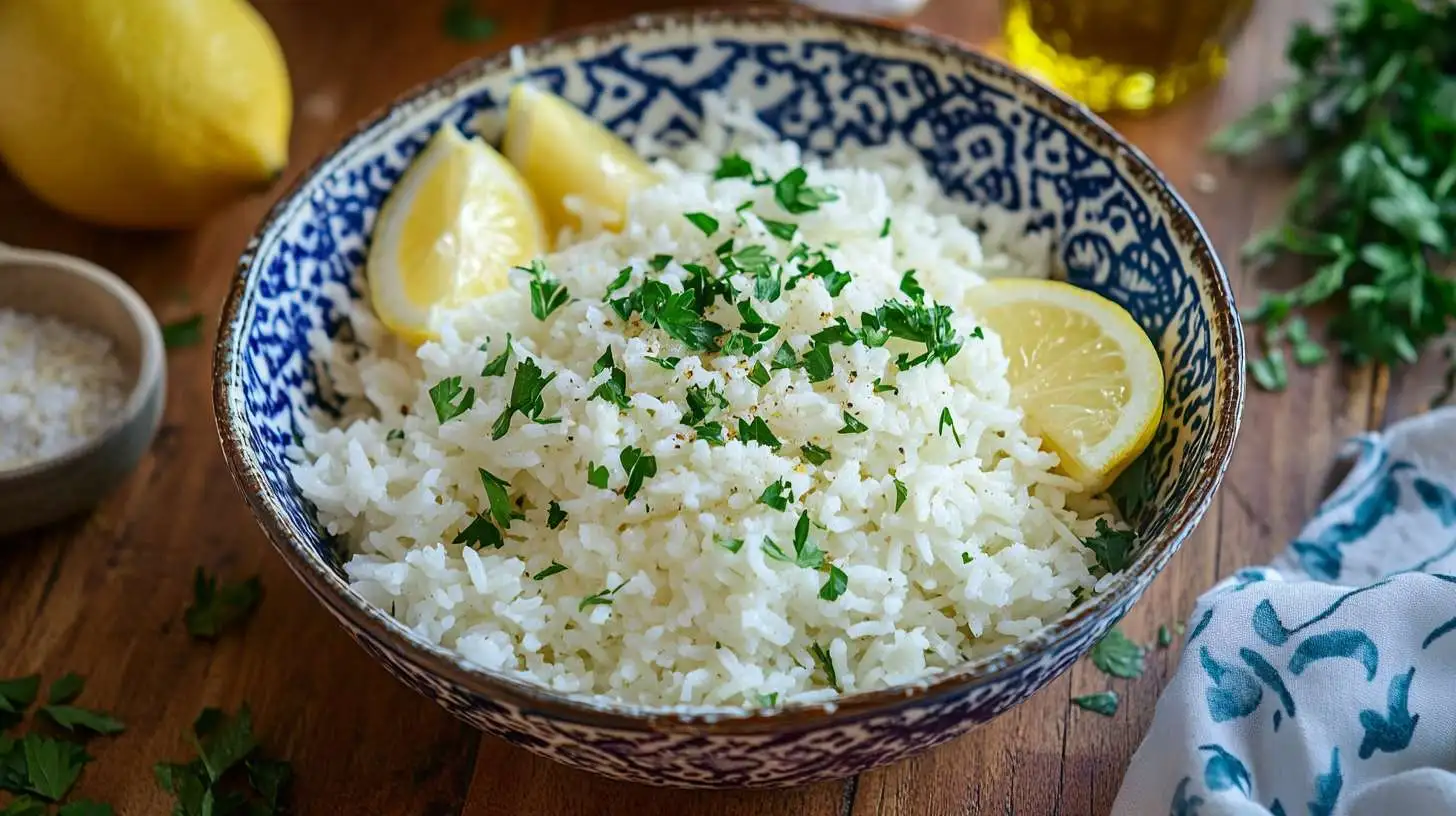Table of Contents
Greek cuisine is all about simplicity, flavor, and tradition, and the Greek rice recipe perfectly captures that essence. Whether you’re hosting a Mediterranean-themed dinner or simply craving a hearty yet healthy side dish, Greek rice is a go-to option.
This guide will not only walk you through the basics of making a perfect Greek rice dish but also dive into variations, troubleshooting tips, and nutritional insights. Ready to bring a taste of Greece into your kitchen? Let’s get started!
Introduction to Greek Rice: A Mediterranean Delight
Greek rice, often referred to as “Rizi” in Greece, is a staple dish that embodies the flavors of the Mediterranean. Imagine fluffy grains of rice infused with olive oil, garlic, lemon, and fresh herbs—doesn’t that sound heavenly?
The beauty of Greek rice lies in its versatility. It can stand alone as a vegetarian main course or act as the perfect side dish for grilled meats, seafood, or roasted vegetables. Whether you’re a beginner or a seasoned home cook, this dish will make you feel like a Greek chef in no time.
Why Greek Rice is a Staple in Mediterranean Cuisine

Greek rice isn’t just delicious it’s deeply rooted in Mediterranean culture. The Greeks have mastered the art of combining simple ingredients to create bold flavors. But what makes this dish so popular?
The Cultural Significance of Rice in Greek Cooking
Rice has been part of Greek cuisine for centuries, thanks to its affordability and adaptability. In Greek households, rice dishes often accompany family gatherings, religious celebrations, and festivals.
“Rice in Greek culture represents nourishment and unity, as it brings people together around the table.”
From hearty pilafs to lemon infused variations, rice is more than just food in Greece it’s a symbol of hospitality and warmth.
Health Benefits of Greek Rice Dishes
You might be wondering can something this tasty be healthy? Absolutely! Greek rice dishes are loaded with nutrients, especially when prepared with wholesome ingredients like olive oil, garlic, and vegetables.
Key Health Benefits of Greek Rice:
- Rich in Fiber: Keeps digestion smooth and satisfying.
- Good Fats: Olive oil provides heart healthy fats.
- Low in Calories: Perfect for weight conscious eaters.
- Gluten-Free: Ideal for those with gluten intolerance.
Who knew healthy could taste this good?
Key Ingredients for a Traditional Greek Rice Recipe
To make authentic Greek rice, you’ll need a few pantry staples and some fresh ingredients. Let’s take a look:
Choosing the Right Type of Rice for Greek Recipes
The type of rice you use can make or break your dish. For Greek rice, medium-grain or long-grain white rice works best. Why? It absorbs flavors beautifully without turning mushy.
Pro Tip: Avoid instant rice—it doesn’t hold up well during cooking and lacks texture.
Essential Spices and Herbs for Authentic Greek Flavor
Greek rice is all about layering flavors. Here are the must-have spices and herbs:
- Garlic and Onion – The aromatic base of any Greek dish.
- Bay Leaves – Adds depth and fragrance.
- Dill and Parsley – Fresh herbs that brighten the dish.
- Lemon Zest and Juice – For that signature tangy flavor.
- Salt and Pepper – Simple but crucial.
Fresh Vegetables and Broth: The Foundation of Flavor
Instead of plain water, Greek rice gets its flavor from vegetable or chicken broth. It’s like giving your rice a flavor bath it soaks up all that goodness!
You can also toss in veggies like tomatoes, spinach, or peas to add color and nutrition.
Step-by-Step Instructions for the Perfect Greek Rice Recipe
Now for the fun part cooking! Follow these simple steps to create a restaurant-quality Greek rice dish.
Preparing the Ingredients: Tips and Tricks
- Rinse the Rice: Always rinse your rice under cold water to remove excess starch. This prevents it from becoming sticky.
- Chop Veggies and Herbs: Prep everything beforehand for smooth cooking.
- Measure Ingredients: Precision is key don’t eyeball it!
Cooking Techniques for Fluffy and Flavorful Rice
- Sauté Aromatics – Heat olive oil in a large pan, then add garlic and onions. Cook until fragrant.
- Toast the Rice – Add rice to the pan and lightly toast it for 2–3 minutes. This step enhances flavor.
- Add Broth and Spices – Pour in broth, lemon juice, bay leaves, and salt. Stir gently.
- Simmer, Don’t Boil – Reduce the heat, cover the pan, and let the rice cook slowly. Resist the urge to stir it disturbs the process.
- Fluff and Serve – Once cooked, remove from heat and fluff with a fork. Garnish with parsley and lemon slices.
Adjusting Seasonings for Personal Preferences
Taste and tweak! Prefer it more tangy? Add extra lemon juice. Need more spice? Sprinkle in some chili flakes. Cooking is all about making it your own.
Popular Variations of Greek Rice Dishes

If you’re feeling adventurous, here are a few delicious variations you can try:
Lemon Rice (Rizi Lemonato): A Zesty Favorite
This version highlights lemon as the star ingredient. It’s light, tangy, and pairs beautifully with grilled chicken or fish.
Spanakorizo: Greek Spinach Rice for Vegetarians
Love greens? Spanakorizo combines spinach and dill with rice, creating a nutrient-rich vegetarian option.
“Spanakorizo is a Greek grandma’s secret to sneaking veggies into meals.”
Tomato Rice (Ntomatorizo): A Savory Twist
Rich in tomato flavor, this version is perfect for comfort food lovers. Think of it as the Mediterranean cousin of risotto.
Common Problems When Cooking Greek Rice and How to Solve Them
Let’s face it cooking rice doesn’t always go as planned. But don’t worry! Here’s how to tackle common issues:
Why Does My Rice Turn Out Mushy? Fixing Texture Issues
- Problem: Too much water or overcooking.
- Solution: Use the correct rice-to-liquid ratio (1:2). If it’s already mushy, spread it out on a baking sheet to dry.
How to Avoid Bland-Tasting Rice: Flavor-Enhancing Tips
- Problem: Not enough seasoning.
- Solution: Cook the rice in broth instead of water and add herbs during cooking, not after.
Dealing with Overcooked or Undercooked Rice
- Overcooked: Fluff the rice with a fork and let it sit uncovered.
- Undercooked: Add a splash of broth, cover, and simmer for 5 more minutes.
Nutrition Facts for Greek Rice
| Nutrient | Amount (Per Serving) |
|---|---|
| Calories | 180 |
| Protein | 4g |
| Carbohydrates | 35g |
| Fiber | 2g |
| Fat | 5g |
| Saturated Fat | 0.7g |
| Sodium | 200mg |
Serving Suggestions and Pairing Ideas for Greek Rice

Greek rice isn’t just a side dish it’s the star of the table when paired with the right accompaniments. Whether you’re planning a casual family dinner or a festive gathering, here’s how to make your Greek rice shine.
Perfect Side Dishes to Complement Greek Rice
Greek rice pairs beautifully with both vegetarian and meat-based dishes. Some popular options include:
- Grilled Chicken Souvlaki – Skewered, marinated chicken that’s juicy and flavorful.
- Lamb Gyros – Thin slices of seasoned lamb served with tzatziki sauce.
- Stuffed Bell Peppers (Gemista) – A classic Greek dish filled with rice and herbs.
- Baked Feta Cheese with Olives – Creamy, tangy feta straight out of the oven.
- Greek Salad (Horiatiki) – Fresh tomatoes, cucumbers, and feta topped with olive oil.
Ideal Drinks and Wines for a Mediterranean Feast
No Greek meal is complete without a drink to toast the occasion. Here are a few suggestions:
- White Wine – Crisp and refreshing wines like Assyrtiko or Sauvignon Blanc.
- Red Wine – Bold choices like Agiorgitiko pair well with lamb and tomato-based rice.
- Ouzo – An anise-flavored aperitif that’s iconic in Greek culture.
- Lemon Water – Simple yet refreshing for a non-alcoholic option.
“Pairing food and drinks is like dancing—when done right, they complement each other perfectly.”
Nutritional Information: Is Greek Rice Healthy?
Greek rice isn’t just delicious it can also be incredibly nutritious. Let’s break down the health aspects so you can enjoy it guilt-free!
Caloric Breakdown and Macronutrient Content
| Nutrient | Amount (Per Serving) |
|---|---|
| Calories | 180 |
| Protein | 4g |
| Carbohydrates | 35g |
| Fiber | 2g |
| Fat | 5g |
| Saturated Fat | 0.7g |
| Sodium | 200mg |
Greek rice is naturally low in fat and rich in carbohydrates, making it a great source of energy. It’s also high in fiber, especially when vegetables are added, supporting digestive health.
Gluten-Free and Vegan Adaptations for Dietary Needs
For those with dietary restrictions, Greek rice is incredibly versatile:
- Gluten-Free: Use plain rice (not pre-seasoned) and gluten-free broth.
- Vegan: Replace chicken broth with vegetable broth and skip any dairy garnishes.
“Healthy eating doesn’t mean giving up flavor—Greek rice proves that!”
Tips for Meal Prepping and Storing Greek Rice
Cooking in bulk? No problem! Greek rice is perfect for meal prepping, and it stores well with the right techniques.
Best Practices for Refrigerating and Freezing Rice
- Cool It Quickly – Spread the rice on a baking sheet to cool it down fast.
- Portion Before Storing – Divide into airtight containers for easier reheating.
- Refrigerate for Short-Term Storage – Keeps fresh for 3–4 days in the fridge.
- Freeze for Longer Storage – Lasts up to 3 months in the freezer.
Reheating Greek Rice Without Losing Flavor and Texture
Reheated rice can often turn dry or mushy, but here’s how to avoid that:
- Microwave Method: Add a splash of water and cover the rice with a damp paper towel. Microwave in 30-second intervals until warm.
- Stovetop Method: Reheat in a pan with a little olive oil or broth. Stir gently to keep it fluffy.
- Oven Method: For larger portions, cover with foil and bake at 300°F (150°C) for 15 minutes.
“Reheating rice the right way means you can enjoy leftovers that taste as good as fresh!”
Frequently Asked Questions About Greek Rice Recipes
Can I Use Brown Rice Instead of White Rice?
Absolutely! Brown rice is a healthier alternative, packed with fiber and nutrients. Just remember, it requires more liquid and longer cooking time—about 45–50 minutes instead of 20 minutes.
What’s the Best Broth to Use for Greek Rice?
You can’t go wrong with:
- Chicken Broth – Adds rich flavor.
- Vegetable Broth – Perfect for vegetarians and vegans.
- Beef Broth – A bolder option for meat lovers.
Pro Tip: Homemade broth always beats store-bought versions for freshness and flavor.
How Long Does Greek Rice Last in the Fridge?
Greek rice stays fresh for about 3–4 days in the refrigerator when stored in an airtight container. Always reheat it thoroughly before eating to ensure safety.
Conclusion: Master the Art of Greek Rice Cooking at Home
Cooking Greek rice is more than just following a recipe it’s about embracing Mediterranean culture and creating something deliciously simple yet satisfying. Whether you’re preparing it for a quick weeknight dinner or a festive celebration, this dish will never disappoint.
The best part? It’s highly customizable! From adding spinach for a vegetarian twist to spicing it up with tomatoes and chili flakes, Greek rice adapts to your taste and mood.
So, what are you waiting for? Gather your ingredients, put on some Greek music, and let your kitchen fill with the irresistible aroma of herbs and lemon. Your journey to mastering Greek rice starts now OPA!
“Good food isn’t just about feeding the stomach; it’s about feeding the soul. And Greek rice does both beautifully.”

